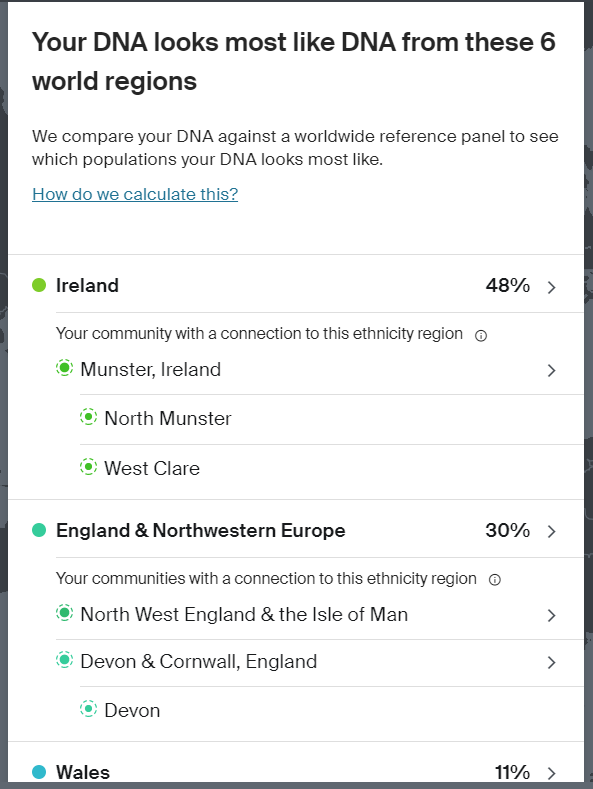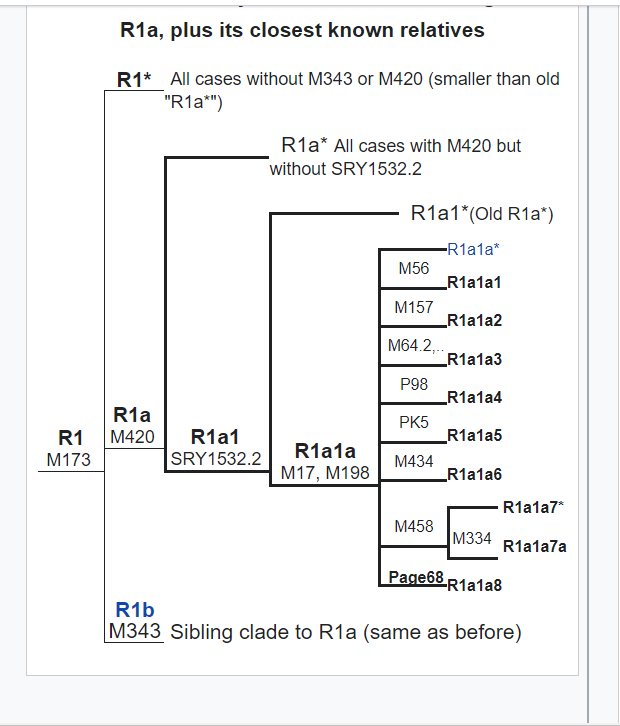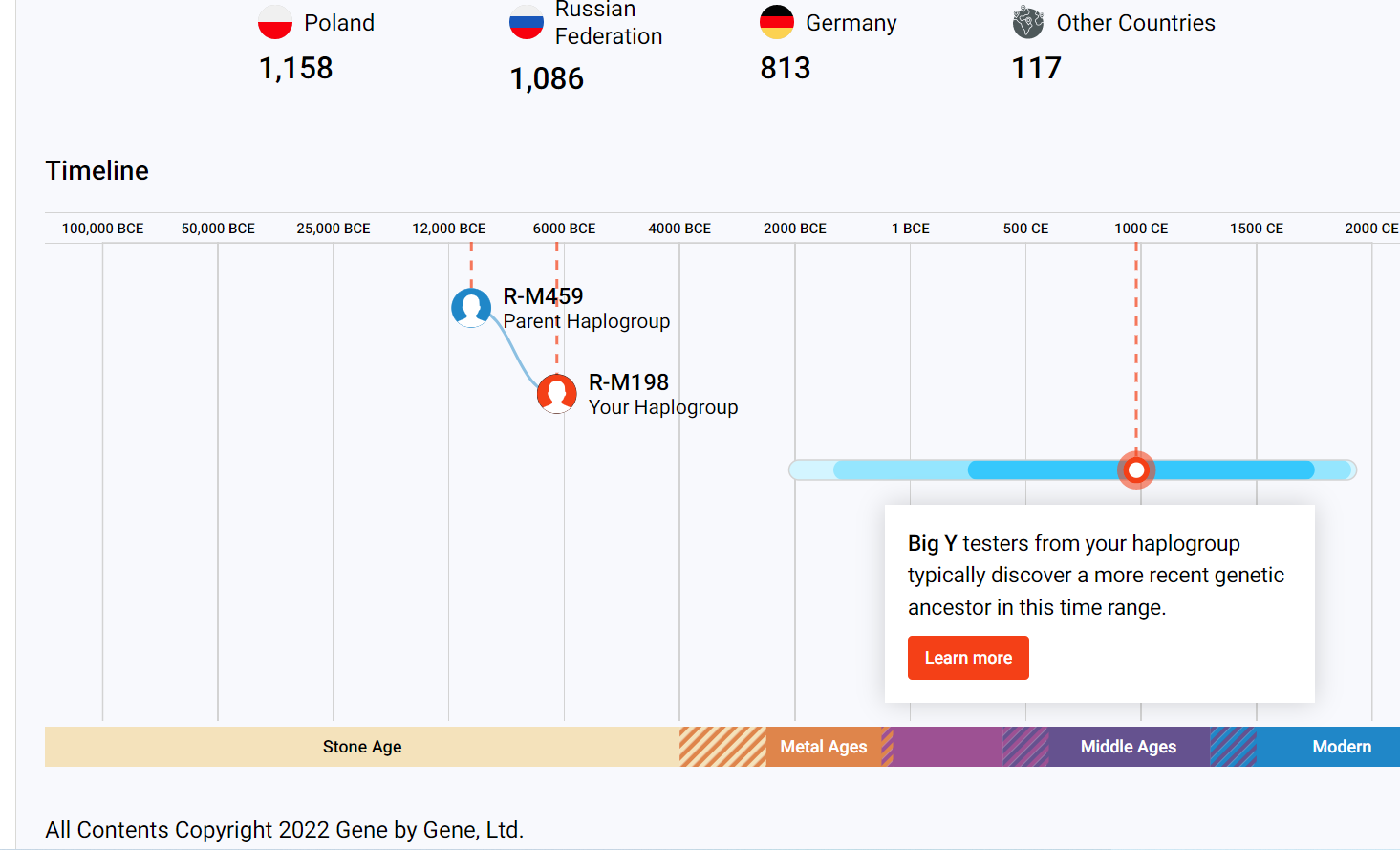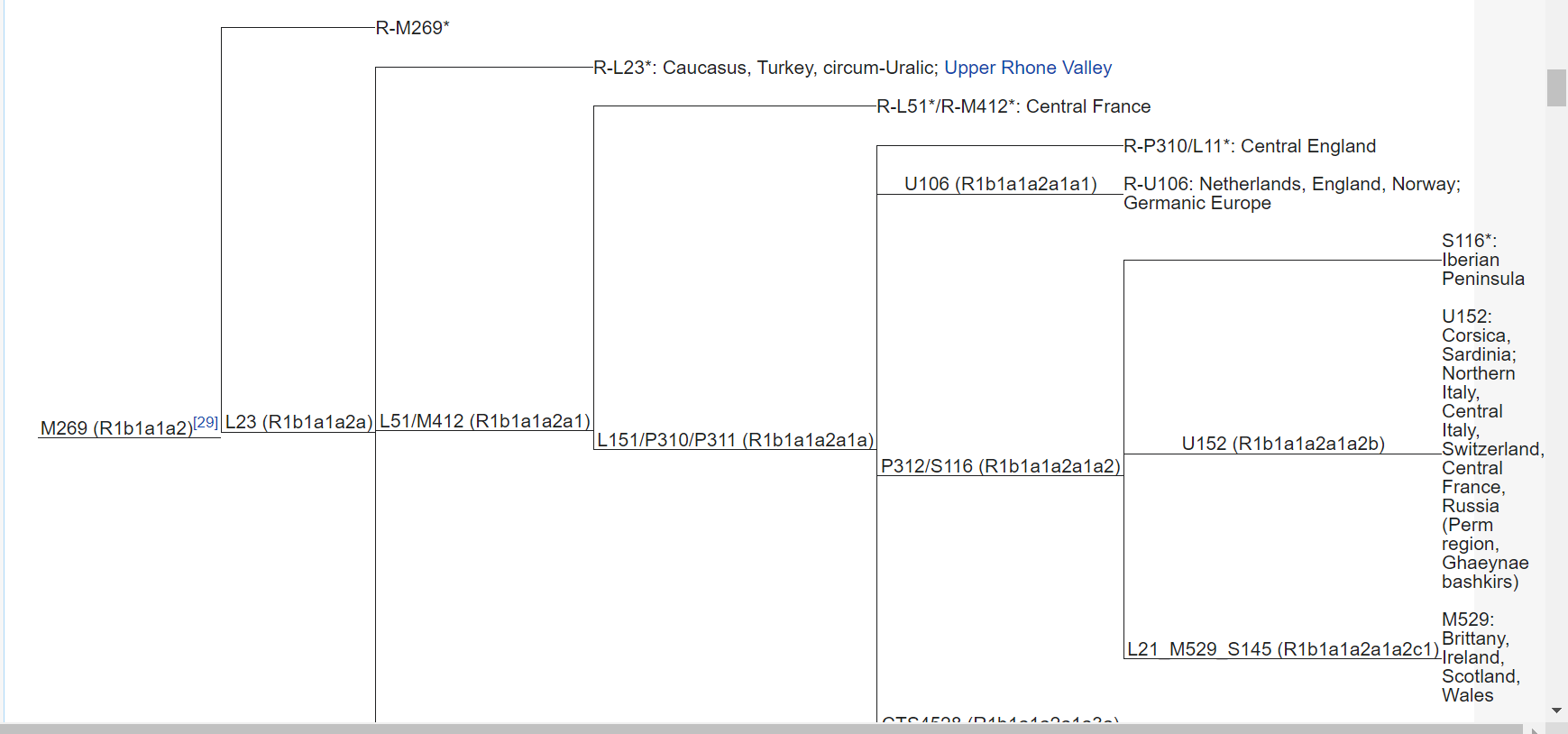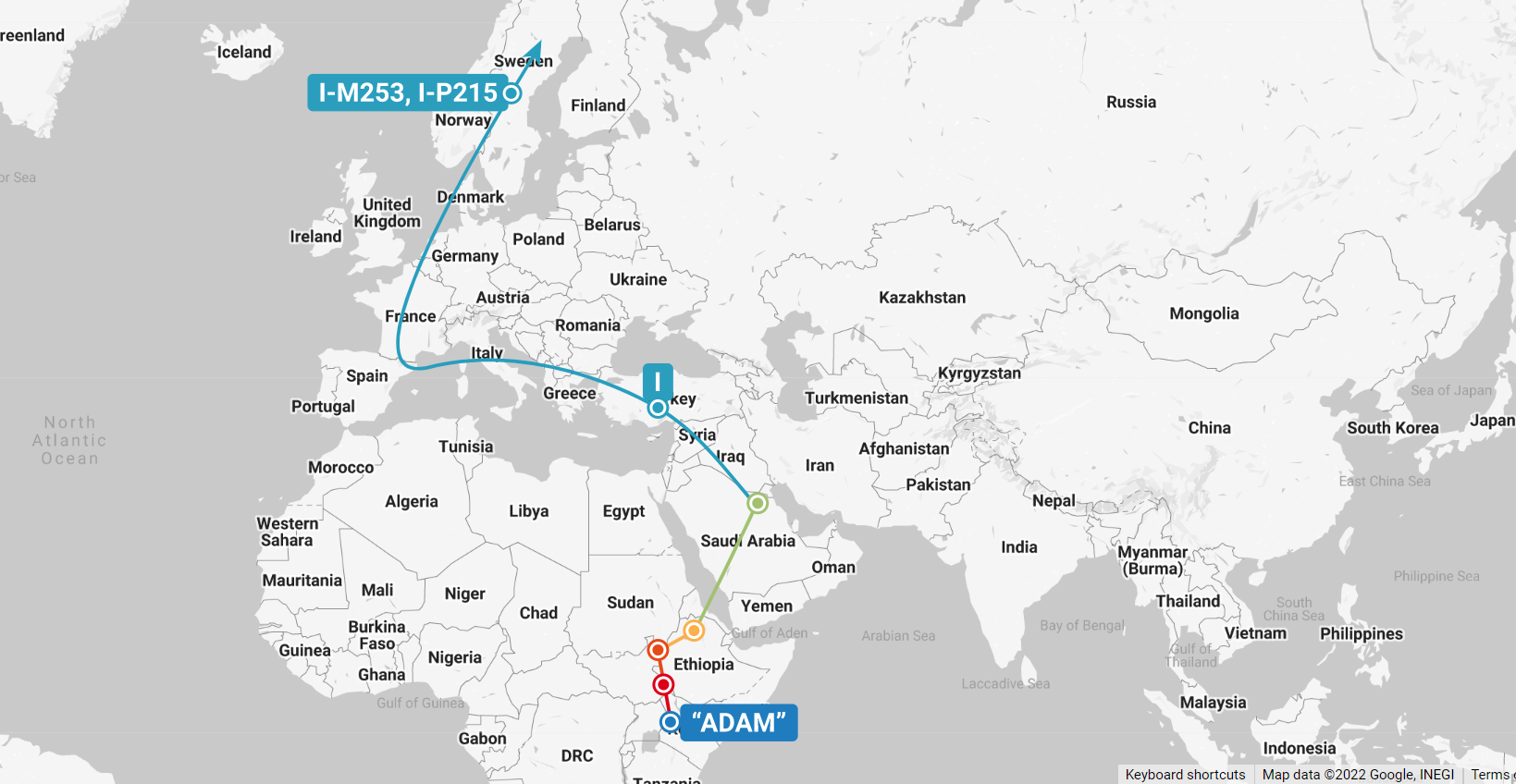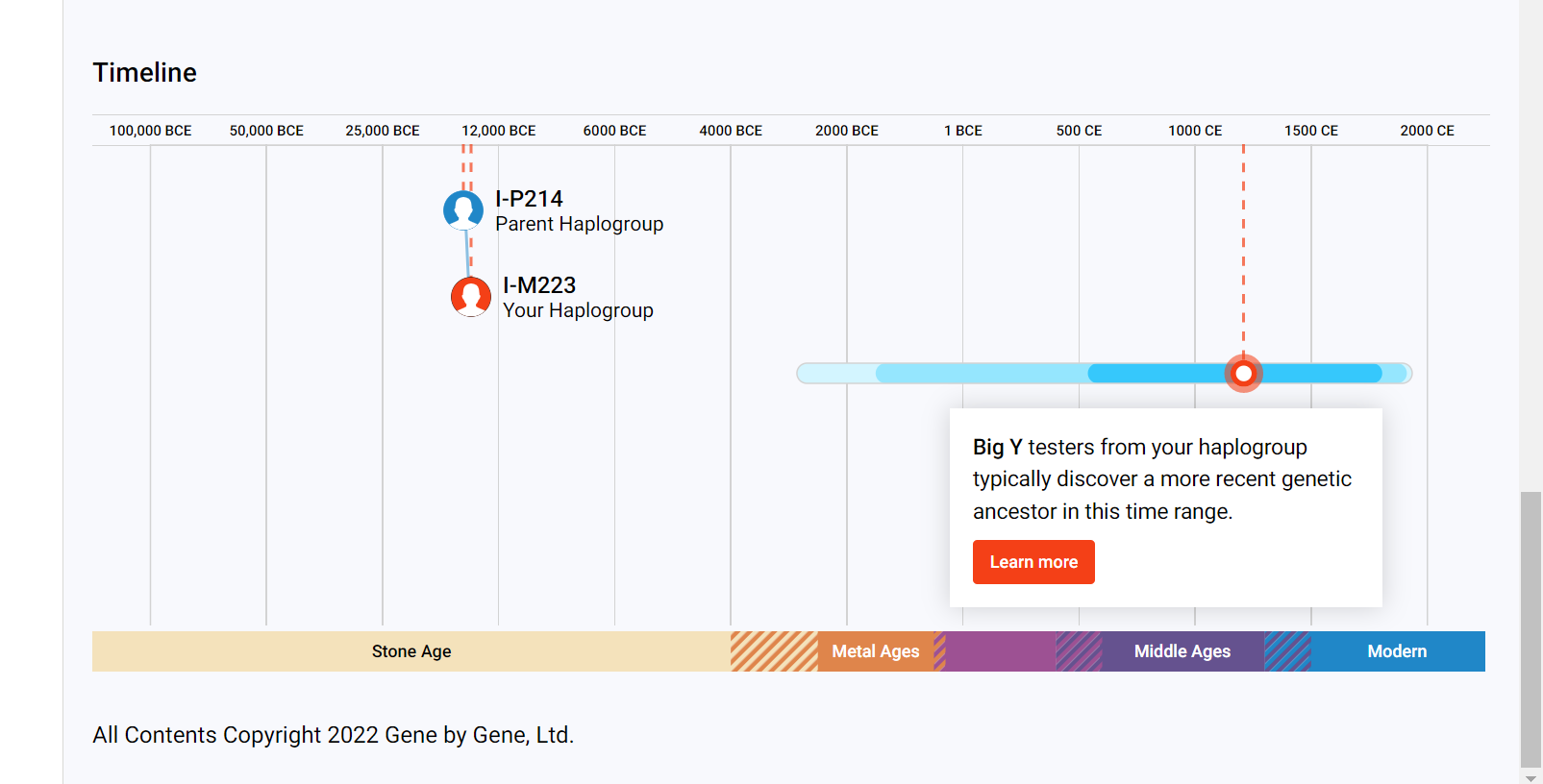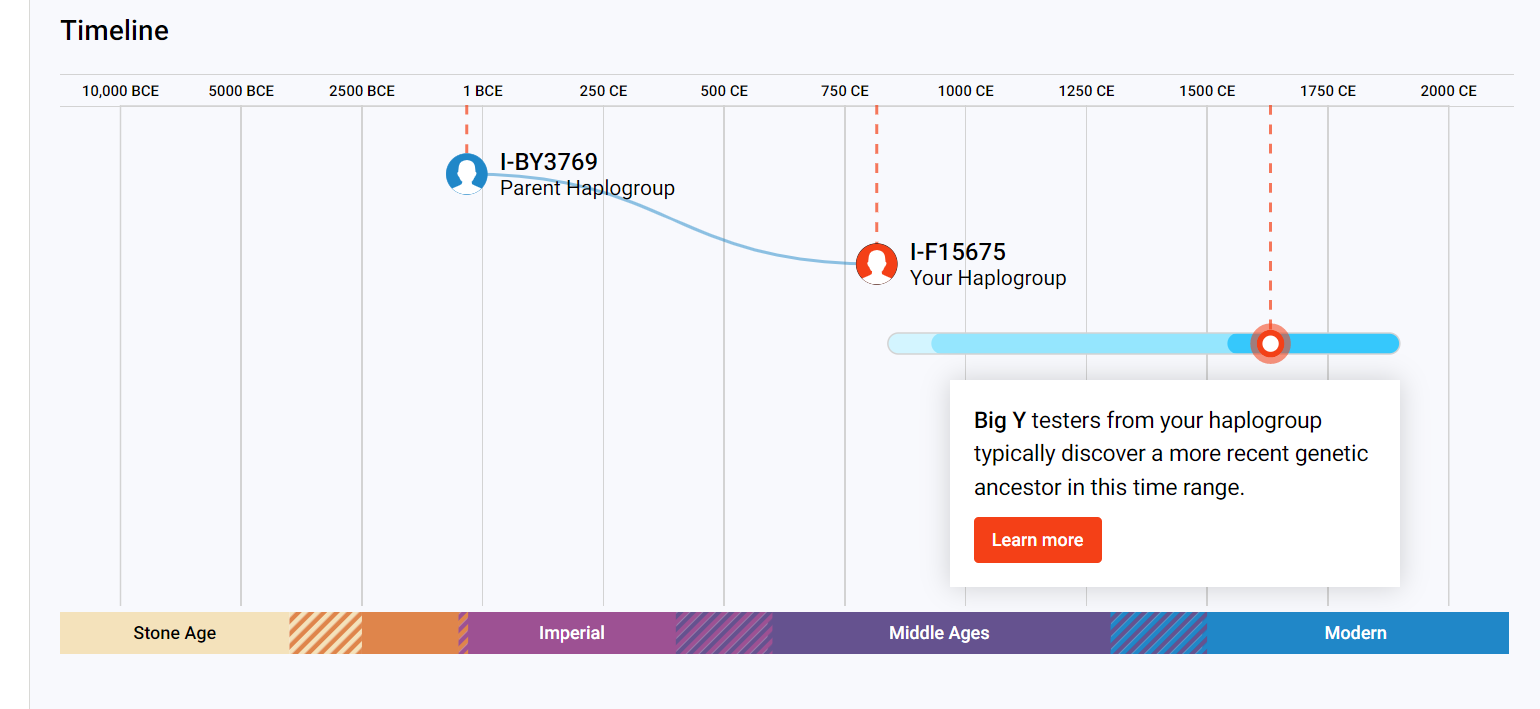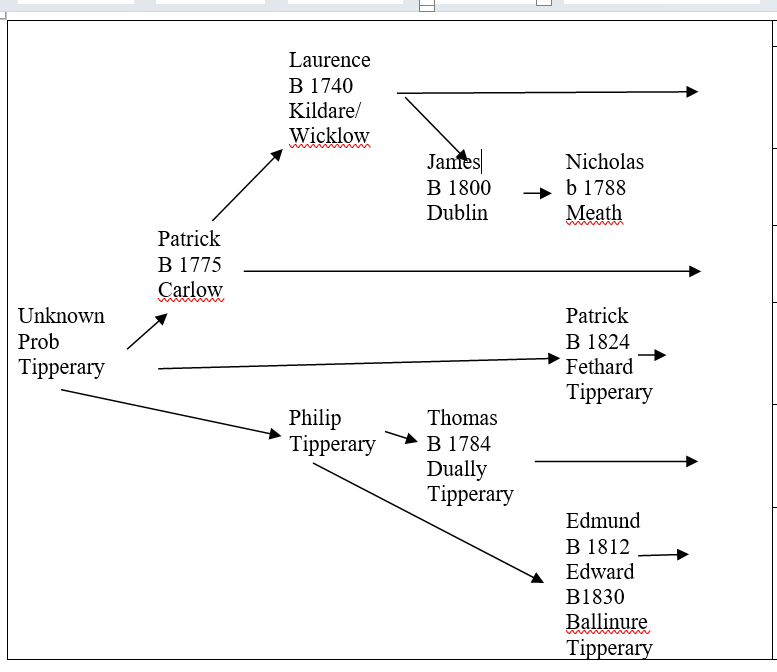DNA Research
A possible DNA Tree of the I-M 223 families is:
The male Y chromosone contained in a DNA sample is passed down the male line virtually intact. Thus, if two male DNAs closely match then it can be scientifically proven that these people are related.
There are two main DNA testing organisations:
- Ancestry.com, and
- FamilyTreeDNA.com
Both organisations test the DNA from saliva samples. The results are however presented differently.
Ancestry.com DNA tests
These results are very user friendly and show:
- Ethnicity – showing regional origins and a DNA history
- DNA matches – showing DNA matches with potential cousins. Various searches are available to narrow down cousins, for example by searching by surnames.
- Family circles – showing others that in your family tree.
However, they do not provide the detail that serious analytical buffs like.
My DNA ethnicity page looks like:
The Wales, North West England and Devon regions link to my maternal side. The Ireland link is my paternal link.
FamilyTreeDNA.com DNA Tests
These tests are much more analytical. They produce tables of results of Short Tandem Repeats (STRs). The Hayde test results look like:
|
Tree # |
Paternal Ancestor Name |
Haplo group |
DYS393 |
DYS390 |
DYS19 |
DYS391 |
DYS385 |
DYS426 |
DYS388 |
DYS439 |
DYS389i |
DYS392 |
DYS389ii |
DYS458 |
DYS459 |
DYS455 |
DYS454 |
DYS447 |
DYS437 |
DYS448 |
|
|
Viking Origin |
|
|
|
|
|
|
|
|
|
|
|
|
|
|
|
|
|
|
|
|
1 |
Thomas Hayde, born circa 1784, Dually, Co Tipperary |
I-M 223 |
15 |
23 |
15 |
10 |
15-15 |
11 |
13 |
11 |
13 |
12 |
32 |
15 |
8- 10 |
11 |
11 |
24 |
14 |
20 |
|
10 |
Thomas Hayde, born circa 1784, Dually, Co Tipperary |
I-M 223 |
15 |
23 |
15 |
10 |
15-15 |
11 |
13 |
11 |
13 |
12 |
32 |
15 |
8 -10 |
11 |
11 |
25 |
14 |
20 |
|
10 |
Edmond Hayde, born 1812, Ballinure, Co Tipperary |
1-M 223 |
15 |
23 |
15 |
10 |
15-15 |
11 |
13 |
11 |
13 |
12 |
32 |
15 |
8- 10 |
11 |
11 |
25 |
14 |
20 |
|
15 |
Patrick Hade born 1775, Co Carlow, Ireland |
I-M 223 |
15 |
23 |
15 |
10 |
15-15 |
11 |
13 |
11 |
13 |
12 |
32 |
15 |
8- 10 |
11 |
11 |
25 |
14 |
20 |
|
9 |
Edward Hayde born abt 1830, Ballinure, Co Tipperary |
I-M 223 |
15 |
23 |
15 |
10 |
15-15 |
11 |
13 |
11 |
13 |
12 |
31 |
15 |
8- 10 |
11 |
11 |
25 |
14 |
20 |
|
6 |
Patrick Hayde b 1824, Fethard, Tipperary |
I-M 223 |
15 |
23 |
15 |
10 |
15-15 |
11 |
13 |
11 |
13 |
12 |
31 |
15 |
8- 10 |
11 |
11 |
25 |
14 |
20 |
|
3 |
Lawrence Heade, born Co Kildare/ Wicklow circa 1740 |
I-M 223 |
15 |
23 |
15 |
10 |
15-15 |
11 |
13 |
11 |
13 |
12 |
31 |
15 |
8- 10 |
11 |
11 |
25 |
14 |
20 |
|
18 |
James Hayde born abt 1800 Dublin, Ireland |
I-M 223 |
15 |
23 |
15 |
10 |
15-16 |
11 |
13 |
11 |
13 |
12 |
31 |
15 |
8- 10 |
11 |
11 |
25 |
14 |
20 |
|
18 |
Nicholas Heade, b 1788, Duleek, Ireland |
I-M 223 |
15 |
23 |
15 |
10 |
15-16 |
11 |
13 |
11 |
13 |
12 |
31 |
15 |
8- 10 |
11 |
11 |
25 |
14 |
20 |
|
|
Norman Origin |
|||||||||||||||||||
|
8 |
John Hayde, b c 1800, Fethard, Co Tipperary |
R-L 48 |
13 |
23 |
14 |
13 |
11-14 |
12 |
12 |
12 |
14 |
13 |
30 |
16 |
9- 10 |
11 |
11 |
25 |
15 |
19 |
|
8 |
John Hayde, b c 1800, Fethard, Co Tipperary |
RM 269 |
13 |
24 |
15 |
11 |
11-14 |
12 |
12 |
12 |
14 |
13 |
30 |
18 |
10- 10 |
11 |
11 |
25 |
16 |
19 |
|
16 |
Christopher Hade, b 1790, Dublin |
RM 269 |
13 |
24 |
15 |
11 |
11-14 |
12 |
12 |
11 |
13 |
13 |
29 |
19 |
9- 10 |
11 |
11 |
24 |
15 |
19 |
|
4 |
Edmond Heade, born 1732, Co Kilkenny, Ireland |
R-U 106 |
13 |
23 |
14 |
13 |
11-14 |
12 |
12 |
12 |
14 |
13 |
30 |
17 |
9- 10 |
11 |
11 |
25 |
15 |
19 |
|
6 |
Patrick Hayde, b 1824 Fethard, Tipperary |
R-P 312 |
13 |
24 |
14 |
11 |
11-14 |
12 |
12 |
12 |
14 |
13 |
31 |
19 |
9- 10 |
11 |
11 |
24 |
14 |
19 |
|
|
German Origin |
|||||||||||||||||||
|
13 |
Hans Haid b 1625, Nuertingen, Germany |
R-M 198 |
14 |
25 |
16 |
10 |
11-14 |
12 |
12 |
11 |
14 |
11 |
30 |
16 |
9-10 |
11 |
11 |
23 |
14 |
20 |
|
|
= Faster mutating markers |
|||||||||||||||||||
This data is explained more at www.familytreeDNA.com.
I have set up a Hayde research project using these results as part of the study. Click here to be directed to this site.
This shows that:
- The DNAs reflect three broad sets of data,
- One set of data relates to the German connection as outlined on the German Families page,
- The other two sets have Irish origins.
The two Irish DNA sets can all be traced back to County Tipperary. An area around Killenaule. As the sets come from the same location, I assume a NPE (non-paternal event) occurred at some stage that introduced the other DNA.
I assume from historical events that the Viking DNA came first and was followed by the Norman DNA.
DNA Matching
Haplogroup R-M198
The German connection relates to haplogroup R-M198 (aka R1a). R1a shows a strong correlation with Indo-European languages of Southern and Western Asia, Central and Eastern Europe and to some extent Scandinavia being most prevalent in Eastern Europe, West Asia, and South Asia.
The haplo tree is:
The haplo timeline is:
Haplogroup R-M343
One of the Irish sets is from Haplogroup R-M343 (aka R1b). This is a very common Haplogroup in Central Europe, Spain, France, Portugal and the British Isles. Sub-groups include R-L48, R-U106 and R-P312, the three groups featured in the Hayde/Hade results.
Note in the Haplo R-M198 section above, R-M343 is a close relative of R-M198.
This set seems to have Norman origins and I have labelled this grouping as of ‘Norman Origin’ on the web site. This is very conceptual at present and the haplogroups are going through continuous further testing. What is interesting is that the Haydes in this group have very similar DNAs to families that have origins in Lancashire. Lancashire is where several of the Protestant Irish landowners originated.
The haplo tree is:
Similar to the Haplogroup R-M343 are the results from R-M269. This is a sub-glade of R-M343 as can be seen above.
The haplo tree for R-M269 and its sub-glades of R-U106 and R-P312 is shown below:
Haplogroup I-M223
The other Irish set is from Haplogroup I-M223 (aka I2a1b1). This Haplogroup has Scandanavian origins. I have labelled this group as of ‘Viking Origin’ in this data. I-M223 is a sub-glade of I-M253 and I-P215.
I-M223 (as extracted from wikipedia)
I-M223 has a peak in Germany and another in eastern Sweden, but also appears in Romania/Moldova, Russia, Greece, Italy and around the Black Sea due to movement of Alans/Sarmatians/Scythians.
Haplogroup I-M223 has been found in over 4% of the population only in:
- Germany, the Netherlands, Belgium, Denmark, probably moving tribes of Dacians.
- England (excluding Cornwall), Scotland, possibly descendants of the Iazyges, Legio VI Victrix, 175 410 AD
- The southern tips of Sweden and Norway in Northwest Europe
- The provinces of Normandy, Maine, Anjou, and Perche in northwestern France
- The province of Provence in southeastern France
- The regions of Tuscany, Umbria, and Latium in Italy
- Moldavia and the area around Russia’s Ryazan Oblast and Republic of Mordovia in Eastern Europe maybe Agathyrsi, Khazars
Of historical note, both haplogroups I-M253 and I-M223 appear at a low frequency in the historical regions of Bithynia and Galatia in Turkey, possibly descendants of the Thracians, Cataphract of Alexander the Great at 334 BC, and Varangians, who are historically recorded to have invaded those parts of Anatolia from the 9th to 11th centuries. They ventured southwards along the rivers of Eastern Europe, connecting Scandinavia with Constantinople and Byzantine Empire. Haplogroup I2a2a also occurs among approximately 1% of the Sardinians – Vandals].
This Y-DNA map looks like:
The timeline for haplo I-M223 is:
BCE = Before Common Era or Before Christian Era.
There is also a group studying this origin in more detail and as the research progresses these origins will become clearer.
Sub Glade 1-F15675
Subsequent testing of I-M223 markers shows that our subglade is I-F15675. A timeline for this sub glade is:
A possible DNA Tree for I-M223 families is:
